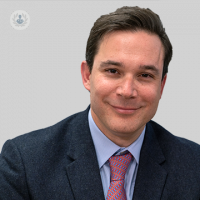Is working in an office giving you tennis elbow?
Autore:We know that office work makes us sedentary, not to mention causing back problems in the long-term. Did you know it can cause elbow problems as well? In this article we asked experienced consultant orthopaedic surgeon Mr Ioannis Polyzois to explain how tennis elbow can affect office workers – and what you can do about it.

What is tennis elbow?
Tennis elbow, also known as lateral epicondylitis, is by far the most common elbow condition that we see in practise. It is a condition that involves pain on the outer aspect of the elbow as well as swelling and tenderness. In medical terms, it is a chronic recurring condition called tendinosis which involves microtrauma and repetitive injury to the area of the lateral epicondyle.
Paradoxically, less than 10% of people who suffer from tennis elbow have actually played tennis.
Why can tennis elbow affect office workers?
Tennis elbow is incredibly common in office workers. We sit at a desk all day typing on the computer or work with our mouse, we get pain and tenderness as well as swelling in the forearm muscles especially pain on the outer aspect of the elbow. This can be debilitating and sometimes people are unable to open a door or shake someone's hand.
There is also morning stiffness that people can experience and the inability or disability to grasp objects at a distance. This obviously becomes a nuisance after some time, because you cannot go about doing your activities of daily living – including sports and hobbies.
If this persistent dull ache carries on for the first three weeks and you find you're unable to complete your activities of daily living at work, in the office or even at home, you should not hesitate to go and see your general practitioner or a specialist.
What is the first line of treatment for tennis elbow?
Physiotherapy is crucial and an integral part of the pathway in tennis elbow treatment. Physiotherapy involves stretching the extensor tendon along the lateral epicondyle. Performing stretches in the first four to six weeks is highly beneficial for tennis elbow treatment. After this, patients can do strengthening activities which will cure the problem long-term.
Do you recommend injections for tennis elbow?
As far as injections are concerned, I do not recommend steroid injections. There is some recent literature that has shown that steroids can be harmful in the long term for tennis elbow.
However, new information has come to light with regards to platelet-rich plasma injections, otherwise known as PRP. What PRP involves is taking blood out of the patient's arm, then putting that sample in a special machine called a centrifuge machine. The blood spins for five to ten minutes and then we re-inject the blood back into the affected area. The platelet-rich plasma protein has been enriched with cells that we all have in our own body called platelets. The platelets contain different growth factors that are involved in dealing with inflammation and dealing with the pain, and can sometimes even promote healing to the damaged tissue.
I strongly recommend platelet-rich plasma protein treatment to patients that come and see me in the acute stages of tennis elbow.
When is surgery required for tennis elbow?
Surgery is reserved for those very resistant cases that fail to respond to non-operative management, such as injections and physiotherapy. Surgery involves a general anaesthetic and a small incision along the lateral epicondyle of the elbow, releasing the diseased portion of the tissue that is inflamed, and reattaching the healthy tissue back on the bone with special anchors. This can be done either by open surgery with a small incision, or sometimes via arthroscopic elbow surgery depending on the severity of the condition.
It is rare that I advocate surgery, because in the vast majority of cases, non-operative management works very well.
In most cases, tennis elbow is a self-limiting condition and variably it will settle without any additional treatment. However, this may take a few months and up to two years in a lot of cases. It is not uncommon for this to become very chronic and for people to be debilitated by this. That is exactly the reason why you should not wait that long for this to happen. It’s important to seek treatment early and specifically and come and see a specialist orthopaedic surgeon to have a personalised treatment plan with regards to platelet-rich plasma injections and physiotherapy. That way, your quality of life will improve much more quickly.



